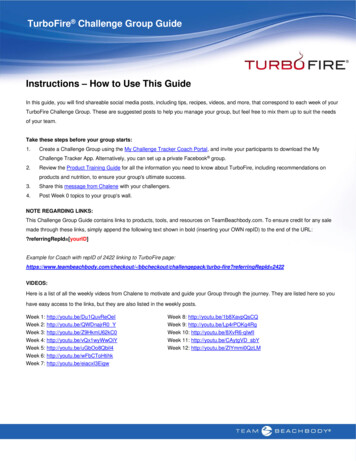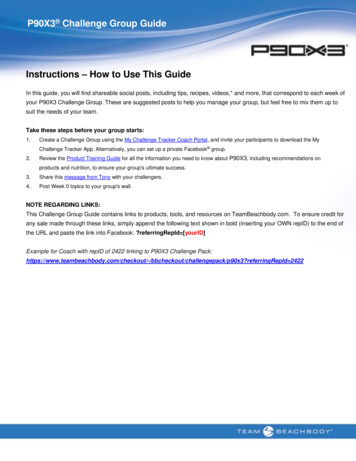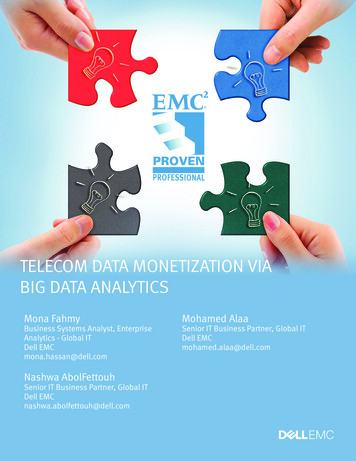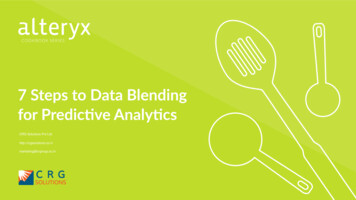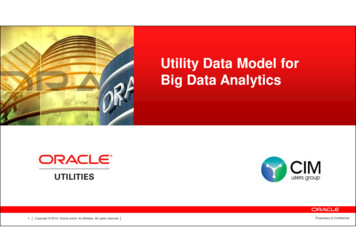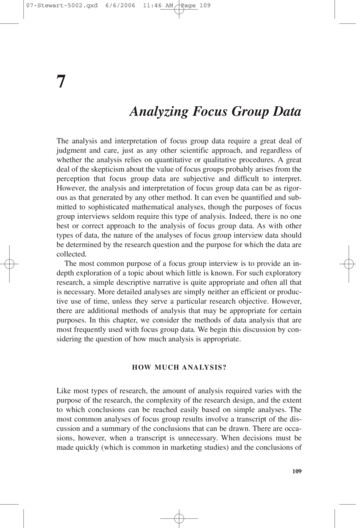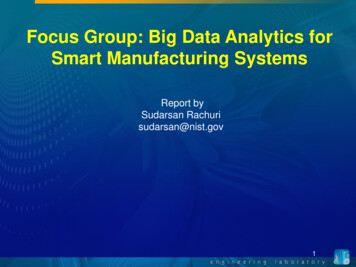
Transcription
Focus Group: Big Data Analytics forSmart Manufacturing SystemsReport bySudarsan Rachurisudarsan@nist.gov1
Improving Manufacturing Efficiency throughPredective Analytics 5% decrease in batch cycle time 10% improvement in machine reliability 10% reduction in water consumption 5% reduction in energy costsSource: www.ge-ip.com
The new ProgramSmart Manufacturing Systems Design and Analysis Objective: The objective is to deliver measurement science,standards and protocols, and tools needed to predict, assess,optimize, and control the performance of smart manufacturingsystems.Major Projects:1. Reference architecture and open solution stack to enable andassess the composable SMS2. Modeling methodology and associated tools to predict, assess, andoptimize the operational performance3. Data analytics and associated methods and tools to enableadaptive system4. Methods and tools for system performance assurance.3
We need to understand thePredictive Analytics WorkflowDatavisualizationStandards and protocols for this information flowDataRawextraction/Data putvalidationData ilter etc. Standardize the predictive models Model definition Model Composition Model chainingData PostprocessingPredictionDecisionStorage/Decision ProcessingScaling,Decision,Scores tandardensurescompatibilityProtocolStandarddefine both thetransmitter andreceiver functionat the same time.
Promise of Big Data Analytics Solution! Concept Architecture Application LayerCAPP, MES, FDC, YMS, Feedback ControlIntegration LayerModel Life CycleLife Cycle ControlCreation Deployment In-Use DisposalDuration Control,Uncertainty ResolutionAnalytics Modeling LayerStatistics ApproachMachine Learning ApproachR, Neural Network, SVM, Decision Tree, Big Data Infrastructure LayerR Hive, Hadoop, HDFS, MapReduce, Data LayerStatic DataDynamic DataProcess Plan (STEP-NC),Production Plan, Master, Monitoring (MTConnect),Metrology, Defect, Shop Floor LayerManufacturing Process
Focus Group Discussion Points Data acquisition issues– In Health care, Manufacturing (discrete,continuous)– Cost of collecting data– Availability of data (real world data and datasimulator)– What are the real implications of volume, velocity,variety, and veracity?– Methods of collecting data (manual, automated)– Open Data Repository6
Focus Group Discussion Points Standards for data acquisition– Data attributes (meta data), unstructured(extracted from text, ), structured (standards),data sampling– Data access and query– Data modeling and data science– Safety data, privacy of data (data masking?)– Open Data Initiative ?– Measurement and metrics for V&V7
Focus Group Discussion PointsAnalytics Modeling– Problem classification: No need for DA, Good to haveDA, must have DA– Data driven Models, Architecture for Data Analytics(common issues for Manufacturing and Health Care– Model Composition, chaining, reuse– Correlation to Cause-Effect Analysis– Analytics Workflow – Standards and Protocols– Moving analytics to the data– More research needed in understanding feature vector(minimal or optimal)– Computing and IT infrastructure for DA8
Data Analytics – Past, Present and FutureData VolumeCurrent DAPastPresentReduce the information overloadCan we get same levelof insights with less data?Future9
Data Layer Analytics Modeling Layer Integration Layer Application Layer Static Data Dynamic Data Statistics Approach Machine Learning Approach Model Life Cycle Life Cycle Control Feedback rol . Neural Network, SVM, Decision Tree

